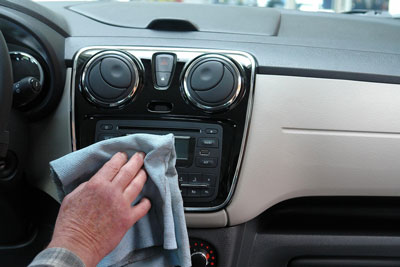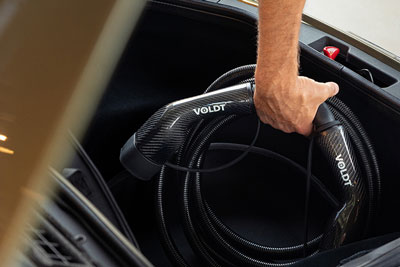Donkervoort D8 GT : le coupé !
16/03/2007
Pour la première fois en 30 ans d'existence, Donkervoort présente un coupé ! La D8 GT conserve les moteurs de la D8 mais ajoute un toit au fameux roadster dérivé de la Lotus Seven.
Hormis son apparence spécifique, la D8 GT innove par ses solutions de réduction du poids et de sécurité dans le segment des sportives ultra-légères. Depuis le record du tour décroché par l'importateur allemand Michael Düchting, sur le fameux Nordschleife circuit wau volant d'une D8 coiffée d'un hard-top, Donkervoort s'est mis dans l'idée d'aller repousser ce record !
La D8 GT est construite sur le même châssis que le roadster D8 mais il a été modifié en de nombreux points pour offrir une meilleure tenue de route. Ainsi, le toit en fibre de carbone fait partie intégrante du châssis, ce quir enforce sa rigidité torsionnelle de 25%. L'objectif était d'obtenir une tenue de route moins dure mais plus efficace. Ainsi la suspension avant est nouvelle (+8 cm) et le train arrière a été revu pour les jantes spécifiques de 17 pouces (+ 4 cm) qui ne pèsent que 6.5 kg. On trouve même un correcteur hydraulique de hauteur tandis qu'en option, le système peut même gérer la fermeté. De même le freinage avec ses étriers 6 pistons en aluminium et ses disques de 300 mm aura de quoi faire pâlir une Porsche 911 !
Light weight
The special use of ultra light materials where possible, makes it possible to achieve the objective of a total weight of the car of 650 kg. For example, the coupé roof is made from two layers of carbon fibre with an integrated roll-cage in between. The ultra light windows are made of polycarbonate, an application specifically developed by GEplastics for the D8 GT, it does not only incorporate ceramic layers for wiper applications it also includes a rear window electric heating. The doors, which are opened upwards and to the front, are also made of carbon fibre. The polycarbonate side windows can be partly opened.
Aerodynamics
The higher speed potential of the D8 GT is achieved through decreased air resistance and the improved down force. The improved Cw value is due to both the smooth coupé roof and the horizontal winglets left and right in which the rear lights are housed. These winglets alone reduce the air resistance by 5%. The under tray is sealed over its entire length with a carbon fibre sandwich plate. This enables the diffuser to work more effectively and real down force is generated. This is a significant step in comparison with the open D8 which is subject to minor lift at high speed. The carbon fibre under plate also contributes significantly to the rigidity of the chassis. The D8 GT is 30 centimetres longer than an open D8, but the wheelbase is the same. The overhang is 8 cm longer at the front and 22 cm at the rear. This has been done primarily to improve the aerodynamics.
Safety
The increased level of active safety of the D8 GT is achieved due to the down force, the increased rigidity of the chassis and the new wheel suspension. The sum total of this should mean not only higher cornering speed levels, but also a safer ride by the combination of smoothness and sharpness. Increased levels of passive safety are the result of the integrated roll-cage which offers a higher level of protection and the crash-zones in the nose and tail. The two vertical vents in the rear are exhaust outlets for the warm air generated by the brakes and the differential. They have been built and strengthened so that both vents and the air tunnels behind them form strong crash boxes which provide resistance in the event of a collision from the rear. The under tray also contributes to the crash resistance of the vehicle by making the chassis extremely resistant to distortion.
Styling
The thrilling and aggressive looks from the D8 GT are the result of its technical features: form follows function. All details on the car have a technical meaning. The wider nose of the car is necessary to house the extra oil and water coolers left and right. New Xenon headlamps have been integrated in the wider nose, also to improve the aerodynamics. These details give the car a new appearance. An important styling element on the back of the car is the diffuser. It creates an effective air stream and leads away the hot air from both the differential and the exhaust. The big openings in the tail also function as cooling ducts. Other styling features are the aerodynamic wings that create down force and in the mean time house the rear lamps of the car.
We plan a maximum production of 50 D8 GT’s per year. Export prices start at 90.000,- euro.
The Donkervoort D8 GT is built on the same chassis as the standard D8 but this has been altered in a number of areas. The front wheel suspension is new and the rear wheel suspension has been modificated for the larger 17 inch wheels. In order to create a smoother ride, the distance between the wheels at the front and rear has been increased by eight and four centimetres respectively. Special shock absorbers have also been developed which have not only a hydraulic automatic height-adjustment but also the option to adjust the stiffness of the absorption in high and low frequencies. The more rigid chassis and the new suspension enable the GT to steer more accurately and precisely. The objective is to create a smoother but also sharper ride. In addition to this, the GT will be faster and safer than the D8.
The underbelly is also sealed over its entire length with a carbon fibre sandwich plate. This enables the diffuser to work more effectively and real downforce is generated. This is a significant step in comparison with the open D8 which is subject to lift at high speed. The carbon fibre underplate also contributes significantly to the rigidity of the chassis. The GT is 30 centimetres longer than an open D8, but the wheelbase is the same. The overhang is 8 cm longer at the front and 22 cm at the rear. This has been done primarily to improve the aerodynamics.
Carbon Fibre
The higher speed potential of the GT is achieved through decreased air resistance and the improved downforce. The improved cW value is due to both the smooth coupé roof and the horizontal winglets left and right in which the rear lights are housed. These winglets alone reduce the air resistance by 5%. Donkervoort uses light materials where possible and the objective is for the GT to be a maximum of 20 kilo’s heavier than a standard D8, which weighs just 630 kilograms. The coupé roof is made from two layers of carbon fibre with an integrated roll-cage in between. The windows are made of polycarbonate, an application developed by General Electric specifically for the GT, including rear windscreen heating. The doors, which are opened upwards and to the front, are also made of carbon fibre. The polycarbonate side windows cannot be wound down but it will be possible to partly open them. Donkervoort has a positive history with closed cars. The car in which the German Donkervoort dealer, Michael Düchting, has already broken the well-known lap record at the Nordschleife circuit was fitted with an experimental hard-top. The D8 GT was developed on the basis of this experience and this means that Donkervoort thinks that there is a good chance to improve on this record once again.
Safer
The increased level of active safety which Donkervoort promises is achieved due to the downforce, the increased rigidity of the chassis and the new wheel suspension. The sum total of this should mean not only higher speed levels through the bend, but also a safer ride. A combination of smoothness and sharpness. Increased levels of passive safety are the result of the integrated roll-cage which offers a higher level of protection and the crash-zones in the nose and tail. The two vertical vents in the rear are exhaust outlets for the warm air generated by the brakes and the differential. They have been built and strengthened so that both vents and the air tunnels behind them form strong crash boxes which provide resistance in the event of a collision from the rear. The underplate also contributes to the crash resistance of the vehicle by making the chassis extremely resistant to distortion.
Donkervoort plans a maximum production of 50 D8 GT’s per year. Prices will be announced in 2007.
ACTUALITES DONKERVOORT
[Collector] La Donkervoort F22 Final Five fait ses adieux au 5 cylindres
Le constructeur néerlandais de voitures de sport Donkervoort a lancé la dernière itération de son coupé F22, sous le nom de Final Five. Elle rend homm...
Lire la suite
[Collector] Donkervoort F22 Art Edition
Le petit constructeur Donkervoort n'est pas spécialement réputé pour ses Art Cars mais il ne faut jamais dire jamais. La preuve avec cette F22 présent...
Lire la suite
Donkervoort F22 Bare Naked : carbone brut en option
Le traitement Bare Naked de Donkervoort a été lancé à l'origine en tant que série limitée de la D8 GTO. Cette finition spéciale revient au catalogue e...
Lire la suite

![[Collector] La Donkervoort F22 Final Five fait ses adieux au 5 cylindres [Collector] La Donkervoort F22 Final Five fait ses adieux au 5 cylindres](images/newsmini/Donkervoort-F22-Final-Five-2024.jpg)
![[Collector] Donkervoort F22 Art Edition [Collector] Donkervoort F22 Art Edition](images/newsmini/Donkervoort-F22-Art-Edition-2024.jpg)




